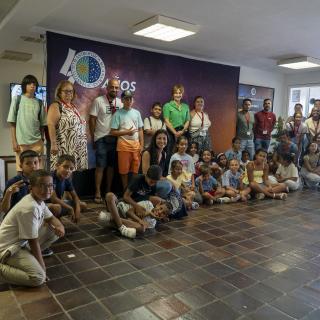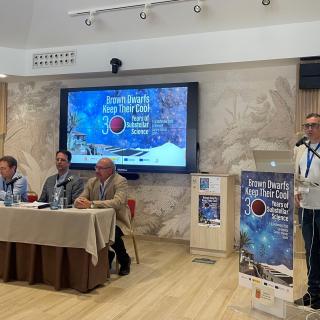Maria Bergemann, astrophysicist at the Max Planck Institute for Astronomy in Heidelberg (Germany), is one of the invited professors at the XXIX Canary Islands Winter School of Astrophysics organized by the Instituto de Astrofísica de Canarias (IAC) in collaboration with the University of La Laguna (ULL). Her classes will be about a very specific type of stars, which are characterized by their temperature, called "late-type stars" and the phenomena and physics that govern them, as well as the challenges posed by these stars from the point of view radiative transport, main topic of the School in this edition.
“The basic astrophysical parameter, which distinguishes ‘late-type’ stars from ‘early-type’ stars is their surface temperature”
“In radiative transfer modelling of late-type stars, the major challenge is to combine consistently their subsurface convection and the densities in the surface layers”
“The solution of the gender equality problem begins with its awareness”
Question: When we think of a star, we use to imagine an object similar to the Sun in size, temperature and composition. This type of “normal” star, however, is not the most common in the Universe: there are dwarfs and giants, reds and blues, so what is a late-type star?
Answer: The definition of a late-type star is very broad: it embraces a wide variety of objects, with different masses, radii, luminosities, and in different evolutionary stages. The basic astrophysical parameter, which distinguishes ‘late-type’ stars from ‘early-type’ stars is their surface (effective) temperature, i.e. the total radiative flux emerging from the stellar surface. Late-type stars are those with spectral types F, G, K and M, corresponding to roughly the effective temperature of the Sun (5777 K), with a variation of 2000 K. Some of these stars have extremely violent dynamics at the surface, some are more quiet (like the Sun), some pulsate, others have strong stellar winds, dusty shells, and lose mass. M dwarfs and M supergiants, although both with vigorous convection penetrating down to very deep layers, are entirely different in radii and lifetimes: M dwarfs are tiny, about 10 time smaller than the Sun, and they live very long, almost ‘forever’ by cosmic scales. In contrast, massive stars - M supergiants - can be as large as our solar system (1500 solar radii).
Q: How can we know the physical properties and processes of these stars?
A: The only way to understand what physical processes occur in stars is through a combination of theory and observations. There are sophisticated state-of-the-art models of stellar atmospheres, which describe how energy escapes from the star into space, and of stellar evolution, which describe the time evolution of energy production in stars and the changes in the global structure of stars from the center to the surface. These models can be used to predict basic ‘observables’, for example the radiation spectra. As it turns out, miniscule changes in physical properties of stars may have radical effects on the emitted radiation spectra. Thus comparing theoretical and observed stellar spectra, we may deduce what physical processes take place inside and at the surface of the observed stars.
Q: Which problems do the late-type stars pose from the standpoint of radiative transfer?
A: Late-type stars have a very sophisticated surface structure, as we know already from observations of our own Sun. The subsurface convection changes the structure of the atmospheres of these stars, and has a great effect on the transfer of radiation in the surface layers. In addition, the densities in the surface layers are so low that the conditions are far from local thermodynamic equilibrium. The major challenge is to combine consistently these two physical ingredients in radiative transfer modelling, and use the resulting model radiation spectra in diagnostic of the fundamental parameters and chemical abundances of stars.
Q: Some week ago, the IAC organized the Gender in Physics Day, a meeting about gender equality in European research centres of Physics. During those days, attendants realized that there is still some gender bias in scientific research, gender pay gap, difficulties in order to promote to senior positions, etc…As a woman and as a scientist leading a group of research, do you ever experienced some of this problems? What is your opinion about this subject?
A: Equal opportunities, which also includes gender balance, is an extremely and relevant topic in modern society. Physics and astronomy are the classical disciplines, where female scientists are traditionally under-represented for a variety of reasons, both historical, social, and cultural. As a teacher at all levels, also often visiting primary schools, I find it devastating to observe how many small girls are in fact interested in astronomy and physics, and how many of them (a few percent) indeed make it to a career of a successful scientist. The solution of the problem begins with its awareness, and different countries and academic systems are nowadays taking active measures to promote astronomy education to minority groups, to support them with additional measures, like mentoring and special opportunity programs. In addition to this, every one of us should actively engage and contribute to solving this society problem, through personal encouragement, support, understanding, and, foremost, fairness and openness to the diversity or attitudes and personalities.
Q: Which specific topics are you going to deal with in the School?
A: My lectures will focus on the physics and phenomenology of late-type stars, touching upon the essentials of physics of the interior structure and stellar atmospheres. We are now evidencing gigantic leaps forwards in this field of astronomy. New fascinating physical mechanisms acting in stars were revealed thanks to the new observations with modern instrument facilities, such as interferometry and high-resolution spectroscopy. Also the development of mulit-dimensional dynamical models, driven by new numerical schemes and availability of powerful super-computers, resulted into new, at times groundbreaking, understanding of stellar structure, lifes and deaths of stars. I will resort to the classical textbook knowledge about late-type stars, but embed it into the new paradigms, which emerged over the past years, in the attempt to give a contemporary overview of the field of physics of late-type stars and to provide an outlook for the future developments.



